
Periods of Human Age
Prenatal Period (280 days before birth)
Intrauterine development is a stage of first manifestations of human motor skills.
1) Newborn child (6 weeks) period of innate reflex movements
2) Suckling (6 weeks to 1 year) period of body straightening, grabbing and locomotion
3) Early childhood (1 to 3 years) period of developing walk, run and handling objects
4) Pre-school childhood (3 to 7 years) period of developing new, mainly overall, movements
5) School childhood (7 to 11 years) period of enhanced motor learning
1) Puberty (11 to 15 years) period of differentiation and redevelopment of motor skills
2) Adolescence (15 to 20 years) period of integration and completing motor development
1) Early adulthood (20 to 30 years) period of the climax of motor efficiency
2) Middle adulthood (30 to 45 years) period of stabilized motor efficiency
3) Late adulthood (45 to 60 years) period of decline in motor efficiency
1) Early old age (60 to 75 years) period of initial involution of human motor skills
2) Middle old age (75 to 90 years) period of involution of human motor skills
3) Late old age (over 90 years) period of decline in human motor skills
Intrauterine Development
Duration: 10 lunar months = 280 days (setting duration of pregnancy, first date according to embryo size, second date according to first outer movements of fetus)
Division:
Embryo period = first two lunar months
Fetus period = the remaining eight lunar months
Fig. 9 Intrauterine development (adopted from http://www.obrazky.cz/)
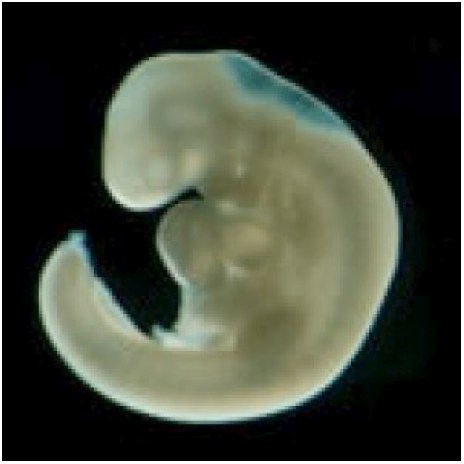
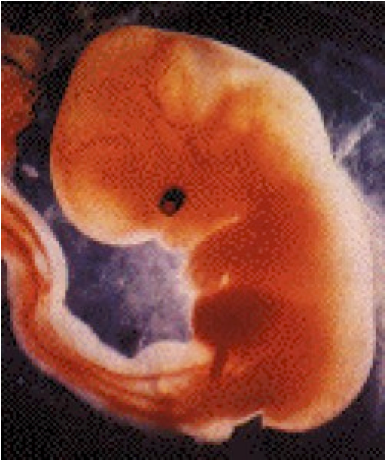
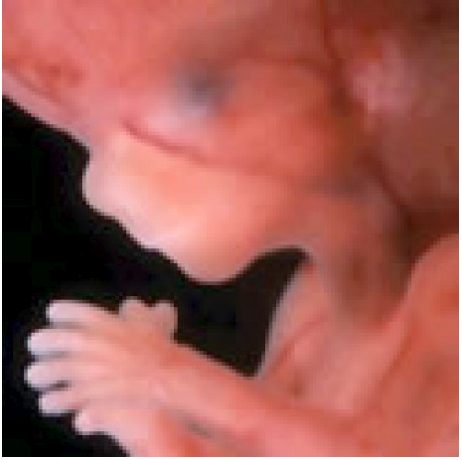
Types of Reflex Movements
Respiratory movements (week 8)
Oral activity and anal reflex (week 9)
Flectional movements of limbs (week 10-11)
Extensor reflex of torso, grabbing reflex and mimics (week 12)
Childhood – new-born child (28 days-2 months)
Somatic characteristics: average weight at birth is 3.5 kg, length at birth is about 50 cm. In the beginning, weight increment is 1-1.5 kg per week at the expense of body fat.
Motor characteristics: holokinetic dynamics prevails (Greek holos = whole): parallel incoordinate movement of all limbs with significant hypertonus of muscles. To judge normality of development, reflex movements are used. We differentiate among:
1) Persisting reflexes: |
- defensive: mechanic, thermic stimuli - feeding: swallowing - organ: winking (video illustration), respiration movements (video illustration) |
2) Fading reflexes: |
- sucking reflex (video illustration) |
3) Burn-out reflexes: (disappearing from 2 to 6 months) |
- tonic neck reflex: head rotation-extension of upper and lower limbs (video illustration) - hugging (More’s): sudden stimulus- balanced movement of upper limbs (video illustration) - walking (climbing): when touching surface alternating lower limbs (video illustration) - crawling: pushing forwards and backwards when lying on stomach (video illustration) - grabbing: strong clutch when a finger is put on palm (video illustration) - swimming: grubbing and kicking movements when lying on back (video illustration) |
Respiration reflex
Holokinetic movement
Walking reflex
Winking reflex
Crawling reflex
Sucking reflex
Tonic neck reflex
Grabbing reflex
Mental characteristics: child sleeps up to 20 hours per day, has positive reactions to close relatives and water; when dived into water, it usually leaves eyes and mouth open but does not breath in water.
Suckling (2-12 months)
Somatic characteristics: gradual completion of new-born growth and transfer to child growth with a regular increment of 3-5 cm per year and 2-3 kg per year. Decreasing ratio of body fat. Significant change of head to body proportion.
Fig. 10 Reaching the upright posture of a child (adapted from Měkota, Kovář, Štěpnička, 1988, 41)

Motor characteristics: period of body straightening, monokinetic dynamics starts to be gradually manifested (2-5 months), muscle hypotony, from 5th to 12th month dromokinetic stage begins, which is manifested by nervous system maturing, beginnings of visual and audio communication and development of the eye-hand connection.
Mental characteristics: significant egocentrism, call for attention, gradual cease of breast-feeding and change to mushy food with lower fat content, intervals between sleep are gradually prolonged from 3 to 6-8 hours.
Early childhood (toddler) 1-3 years
Somatic characteristics: in relation to ending breast-feading, weight increment slowers considerably, deciduous teech start to erupt till the age of 2, child’s silhouette changes (proportion of head and body, greater chest circumference).
Motor characteristics:
toddling starts at the age of 1 (bulgy stomach, torso leans backwards, wide track, bended lower limbs, frequency of 170 steps per minute, unable to keep straight direction)
stairs climbing at the age of 2 (at first it climbs with one foot and pulls up the other one, only later it alternates both feet), child starts to run at the age of 3, it should handle the flight stage at 37 months (106 cm, 16 kg), a simple checking test can be used – 10 m, if the child can make it in less than 6 s, the motion can be regarded a run.
at the age of 1, the child starts to roll objects, below arm throw, at 2 it starts to be able to catch big and light balls (beach balls are most suitable), towards the end of 3rd year, we can start to practice over arm throw
at this age, children naturally seek other locomotive skills such as rollovers, rolls,
hollow hangs, climbing and getting over hurdles, riding tricycles, children bobsleighs and sledges.
Mental characteristics: children of this age demand physical contact with parents in the form of cuddling and caressing, they gradually build social contact, at first many children only play side by side and only later they play together.
Pre-school Childhood (period of child play) 4-7 years
Somatic characteristics: significant change of silhouette, lower heartbeat frequency, increasing proportion of muscles (more precise, decreasing proportion of fat tissue).
Motor characteristics: firming laterality from 4th year on as a result of using tools (cutlery, pencil,…), prolonging the length of step while walking or running, children start jumping (at first dive jumps, later long jump), while throwing and catching hands move towards the ball in this period, child should not be discouraged by quick passes, otherwise the child may keep off its head or close its eyes, other popular locomotive skills include kicking (4-5 years), dribbling (5-6 years), swinging, hanging, slides, supports, rolls, rollovers.
Mental characteristics: entering schools results in accepting social roles, improving thinking and speech (3,500 words), fine motor skills mainly of the upper limbs.
School Children (younger school age) 7-11 years
Somatic characteristics: constant growth (5-6 cm per year, 2-3 kg per year), however, there are cases of first examples of child obesity (it is 6 % with 6-year-olds and 16 % with 8-year olds), at the age of 11 girls surpass boys in height and weight due to earlier maturing. At this age, the way of holding the body is important (school bag carried on both shoulders, stretching after sitting at school for a long time).
Motor characteristics: great docility – a period suitable for developing skills, surplus movements (referred to as locomotion luxury), spontaneous locomotive activity takes up to 5 and half hours a day, hypermotoric (hyperkinetic) children vs. hypomotoric (hypokinetic) children.
Mental characteristics: making first long-term friends, puberty leads to defiance, creating hierarchy of values and presenting own opinions.
Pubescence – period of differentiation and rebuilding motor skills (11-15 years of age)
Somatic characteristics: period of growth spurt (Peak High Velocity), which, apart from child growth, manifests also pubescent growth. Most organs grow, second change of figure. Secondary sex characteristics, sexual maturity.
Motor characteristics: worse coordination of motion (fluency, accuracy), increase in length of running step (40 cm) after prolonging lower limbs by 15 cm, step frequency decrease 4.1 Hz – 3.9 Hz. Dynamics distortion and worse economy of motion. Extremes in motor skills (keenness-flabbiness, managing difficult tasks-scamping easy ones). Locomotive activity is significant with children who do sports – up to 5 hours a day.
Mental characteristics: developing emotions in an emotional way, increased sensitivity, emotional lability, beginnings of formal abstract thinking. Good diet regime is important due to growing (at least 9 and half hours of sleep and healthy diet support growth).
Adolescence – period of integrating motor skills (15-20 years)
Somatic characteristics: finishing physical growth, sexual maturity, fat deposits (boys – single thin layer over the whole body, girls – stomach, bottom, thighs), torso grows in bulk, muscles are visible, woman body rounding.
Motor characteristics:
integrating motor skills and bringing them in harmony Þ second climax of motor skills
Individualization:
- level of development (big range of performance) broad and deep development of motion
characteristics of motion
- scope and intensity of motion
Stabilization:
- correlation coefficient with repeated measuring (e.g. standing jump 0.53 with primary
school children and 0.7 with university students) creating life-style
Motor differentiation according to sex:
- walking (different length of step, girls move their hips) running (different length and frequency of steps) difference in power is approx. 30%, in speed approx 10 % to the benefit of men
- woman are more efficient in skills (mainly in balance, rhythmic abilities and joint moveability)
Mental characteristics: finishing mental maturing (place in typology does not change). Formal logic thinking at a very high level, philosophical thinking, high level of mental creativity in different areas (music, poetic, arts, etc.).
Adulthood (acme)
Differentiation:
- Early adulthood (mecitma): period of reproduction (80 % children are born), forming working motor skills, gaining experience, climax of sports activity, stage of motor performance culmination with majority of sportspeople
- Middle adulthood (adultium): stage of stabilized efficiency, at the beginning first cell changes, at the end the period of menopause begins, climax of scientific and artistic activity, gymnastic activity decreases, it is replaced by healthy walks of lower intensity
- Late adulthood (interevium): stage of decreased motor efficiency, symptoms of chronic illnesses appear (unbalanced daily regime, consequences of modern lifestyle), the repertory of locomotive skills decreases, period of balancing.
Fig. 11 The best performance of E. Zátopek, D. Zátopková and J. Železný (Vobr, 2003)
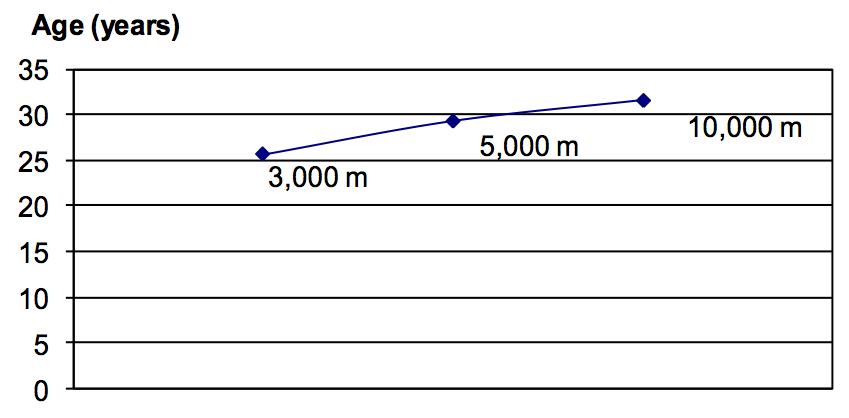
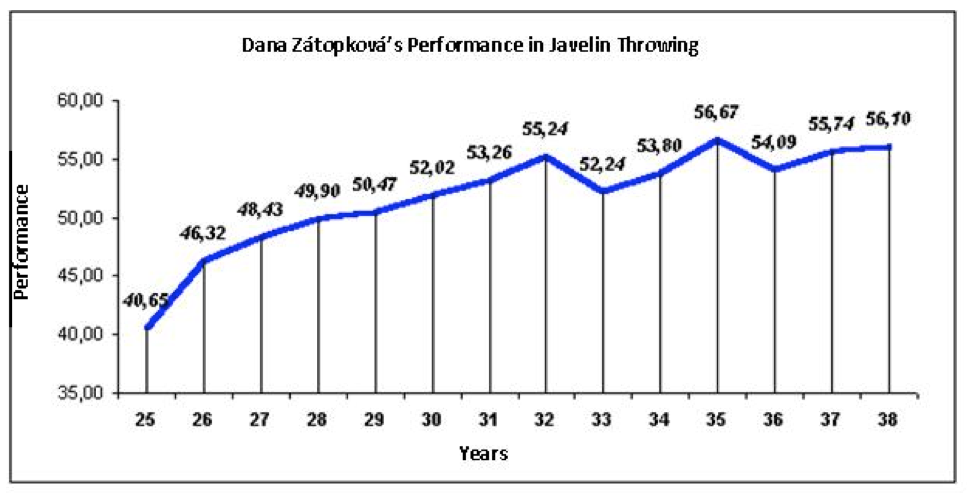
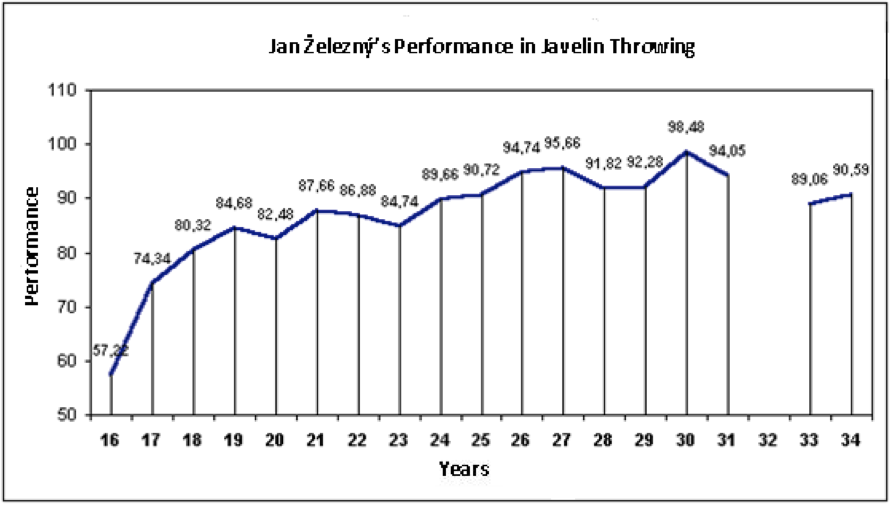
Old Age - senium
Differentiation:
Early Old Age (60-75 years of age)
Middle Old Age (75-90 years of age)
Late Old Age (over 90 years of age)
Biological signs of ageing: visible on all tissues and cells (mainly nervous and endocrine systems), metabolism slows down, adaptability decreases, lower infection resistance, worse sensual perception.
Motor condition: motor abilities regress more dramatically (mainly with speed abilities), less dramatic regression of static-power abilities, endurance abilities decrease by approx. 50 %; such decrease, however, can be positively influenced by training (70-year old marathoners), changes in holding the body (old age kyphosis), length of step shortens (up to 1/4), bad arm coordination, extreme leg raising, axis shift.
Mental signs of ageing: some components of intelligence decrease (memory, engraving), partial egocentrism (solving only one’s own troubles).